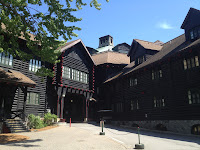 |
| St. Lawrence Commercial Lock |
 |
| Commercial vessels - St. Lawrence |
Opening in 1849, the St. Ours Canal is the final leg of a network that made navigation possible between the St. Lawrence River, Richelieu River, Lake Champlain and the Hudson River. Through this network, Montreal was linked to New York City.
Once inside the Saint Ours Lock, you tie up to a floating dock along the west wall instead of the lock walls. This canal is much wider than the Chambly Canal and the channel is mostly well marked.
Traveling upstream on the St. Lawrence River the surface of the water was flat, still we lost about
two to three knots due to the current, which must be especially difficult (and painful) for sailboats. The river itself is majestic, wide with high banks and more shoals that one can imagine. It is easy to see how the early explorers might have believed that they had discovered the fabled Northwest Passage to the Orient. Instead they got a shortcut to Duluth.
We almost sped through the two commercial locks on the St. Lawrence. Priority is always given to the commercial traffic and there can be long delays. We heard horror stories from a professional captain about waiting seven hours to get through just one of them.
Late afternoon we entered the Lac Saint-Louis, a major Montreal boating center. There were many sailboats ( actually sailing in light air unlike their Florida counterparts) and too many crazed Viagra
boats.
At the entrance to the Ottawa River we tied up to the blue dock at St. Anne de Bellevue Lock. The town has several restaurants and gift shops along the waterfront boardwalk. The Canadians are out in
 |
| Our favorite lock master - St. Ours Lock |
full force - it is a three day holiday weekend called "Queen's Day"- whatever that means.


















































